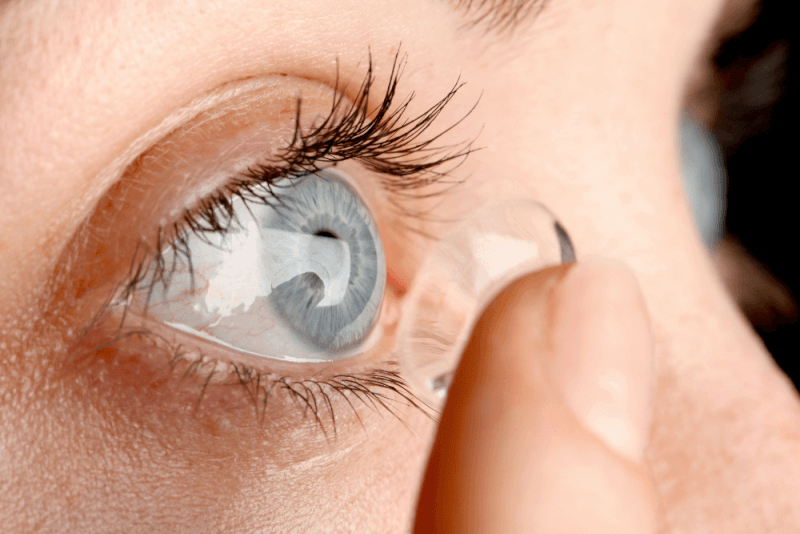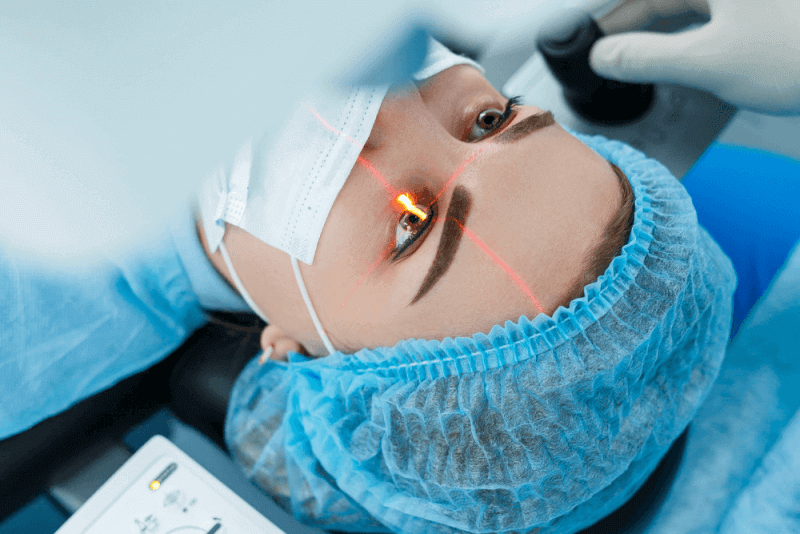What is Strabismus?
Strabismus is the condition where the eyes are not aligned with each other. In this condition, one eye is turned in a different direction from the other. Under normal circumstances, the six muscles that control eye movement work together to move both eyes in the same direction. However, in strabismus, these muscles have difficulty controlling eye movement and cannot maintain normal eye alignment.
Strabismus is often seen in childhood, but it can also occur in adults. Common causes of eye misalignment in adults include stroke and physical trauma. However, untreated or previously treated childhood strabismus can also appear in adults.
Strabismus in Newborns
Eye misalignment seen in newborns is not considered strabismus. This is because the lack of sufficient brain control to keep their eyes steady during the first six months of life can cause their eyes to drift. This condition is referred to as neonatal strabismus.
If strabismus is observed in the first six months of life, a doctor should be consulted. Although this condition is most likely temporary, it is important to confirm whether it is a permanent strabismus to prevent any future health problems for the child.
If the strabismus is significant or if the eye position changes significantly, an eye doctor should be consulted immediately. Additionally, if the strabismus consistently occurs in the same eye, medical advice should be sought.
Strabismus in Children
Among eye disorders, strabismus is the most common problem seen in children. Strabismus in children is not always noticeable from the outside, so it is important to pay attention to the symptoms. Strabismus in children can be caused by genetic factors, systemic diseases, or certain serious eye conditions.
In some cases, visual impairments such as high-degree hyperopia can lead to strabismus. In addition to the standard symptoms of strabismus in children, the following should be observed:
- Closing or squinting one eye when exposed to sunlight
- Tilting the head to one side or forward
- Complaining of double vision in the early stages of strabismus
- Difficulty with reading and writing
- Frequent tripping and falling
What is Pseudostrabismus?
Pseudostrabismus in infants occurs due to the incomplete development of facial features. The wide nasal bridge or the structure of the upper eyelid can give the appearance of misalignment.
In pseudostrabismus, when babies look sideways, it may seem like one or both eyes are misaligned. This condition does not require treatment and usually resolves as the child grows. The difference between pseudostrabismus and true strabismus is not always easy to distinguish, so it is recommended to consult a specialist.
Strabismus Diagnosis Criteria
Any child older than four months who is suspected of having strabismus should undergo a complete eye examination by a pediatric ophthalmologist to evaluate how their eyes focus and move. This evaluation involves the following steps:
- Medical history
- Visual acuity
- Refraction
- Alignment and focusing tests
- Examination after pupil dilation to assess the health of internal eye structures
Other factors that help determine the cause and treatment and should be considered include:
- Whether the strabismus appeared suddenly or gradually
- Whether strabismus was present in the first six months of life
- Whether the same eye is always affected
- The degree of eye rotation
- Whether the strabismus is constant
- Family history of strabismus
Causes of Strabismus
Most cases of strabismus occur due to a problem with the neuromuscular control of eye movements, involving the brain. Less commonly, the problem lies in the eye muscles.
Another cause of strabismus is family history. Approximately 30% of children with strabismus have a similar issue in a family member.
Additionally, there are several risk factors for strabismus, including:
- Uncorrected refractive errors
- Poor vision in one eye
- Cerebral palsy
- Down syndrome
- Hydrocephalus
- Brain tumor
- Stroke
- Damage to the area of the brain responsible for eye movement control, nerves, and eye muscles
- Neurological problems
- Overproduction of thyroid hormone
Symptoms of Strabismus
The symptoms of strabismus include:
- Double vision
- Closing one eye when looking at distant objects or in bright light
- Closing one eye when looking at something nearby
- Difficulty reading
- Headaches
- Eye strain
Treatment Methods for Strabismus
There are many different options for treating strabismus. Specialists will determine the most suitable option or options for the patient and plan the treatment accordingly.
Glasses or Contact Lenses
If uncorrected refractive errors are present, corrective lenses can help keep the eyes straight by requiring less effort to focus.
Prism Lenses
Special lenses that can bend light entering the eye to reduce double vision are also used in the treatment of strabismus.
Eye Exercises
Various eye exercises may be sufficient for treating certain types of strabismus, particularly convergence insufficiency.
Medications
Eye drops, ointments, and certain medications applied to the eye can weaken overactive eye muscles. Medications may be used in conjunction with surgery or as an alternative to surgery, depending on the patient's condition.
Patching
This treatment method, used in patients with amblyopia (lazy eye) along with strabismus, helps improve vision and control eye misalignment.
Strabismus and Botox Treatment
Botox treatment is used to temporarily stop the function of the muscles controlling the eye. This can help bring the eyes into better alignment. Additionally, Botox treatment can help reduce blurred or double vision. However, Botox treatment may also lead to drooping eyelids.
Strabismus and Laser Treatment
Traditionally, laser eye surgeries are not considered one of the treatment options for strabismus because strabismus surgeries involve altering the muscles around the eye, which laser surgery cannot achieve. However, it would be misleading to say that laser eye surgeries cannot be used in the treatment of strabismus, as each individual is different. A procedure called monovision can help those who experience double vision due to strabismus.
Double vision occurs when the brain cannot merge the images from both eyes due to strabismus. To correct this, laser eye surgery can be used to adjust one eye to focus better on distant objects and the other eye to focus better on near objects. This can improve double vision caused by strabismus.
Strabismus Surgery
Another procedure used to treat strabismus is strabismus surgery. This procedure aligns the eyes by tightening or loosening the eye muscles. If other treatment methods do not correct the strabismus, surgery is considered.
Methods of Strabismus Surgery
Strabismus surgery can be performed on one or both eyes. When performed on both eyes, it is referred to as bilateral strabismus surgery. The surgical methods vary depending on the procedure used, including:
- Resection: The muscle is shortened by cutting it.
- Plication: The muscle is shortened by folding it.
- Recession: The muscle is moved back to make it tighter.
- Adjustable surgery, which allows the surgeon to adjust the eye alignment immediately after surgery in the recovery room or clinic to correct any remaining misalignment.
Benefits of Strabismus Surgery
Strabismus surgery can improve the way the eyes work together with 3D vision, especially in children. On the other hand, while strabismus surgery can correct alignment, it may not always improve vision in some cases. For many people, strabismus surgery is seen as a way to achieve a better appearance and boost self-confidence.
Complications of Strabismus Surgery
Strabismus surgery is one of the safest surgeries, but it does carry some risks and complications, including:
- The eyes may drift in the same direction as before the surgery due to recurrent misalignment.
- If overcorrection occurs, the eyes may start drifting in the opposite direction.
- Infection
- Bleeding
- Allergic reactions to anesthesia or medications
- Double vision
- Scarring
- Perforation of the white part of the eye
- Eyelid drooping
Recovery Process After Strabismus Surgery
After strabismus surgery, patients may need to rest for a few days to a few weeks. During this period, the eyes may feel sore, red, and itchy. Complete healing can take up to 12 weeks. Unless otherwise instructed by a doctor, driving should be avoided. For the first two weeks after surgery, swimming in pools, saunas, or hot tubs should be avoided, as these activities can significantly increase the risk of infection.
Risks of Strabismus
While it is believed that strabismus, especially in childhood, will resolve over time, untreated strabismus can worsen. The complications that strabismus can cause include:
- Poor 3D vision
- Eye strain
- Low self-esteem
- Headaches
- Fatigue
- Double vision
- Blurred vision
- Amblyopia (lazy eye)
Types of Strabismus
Strabismus is categorized into different subtypes depending on the direction of the eye misalignment. The types of strabismus include:
- Esotropia refers to the inward deviation of the eye.
- Exotropia refers to the outward deviation of the eye.
- Hypertropia refers to the upward deviation of the eye.
- Intermittent strabismus refers to misalignment that occurs only sometimes.
- Unilateral strabismus refers to misalignment affecting only one eye.
- Alternating strabismus refers to misalignment that alternates between both eyes.
Causes of Strabismus
Strabismus is also categorized into different subtypes based on its causes. The types of strabismus depending on the cause include:
Congenital Strabismus
Eye misalignment seen in infants between 3 to 6 months and 1 year of age is referred to as congenital strabismus. The angle of deviation in congenital strabismus is very high, making it noticeable to everyone. Congenital strabismus generally does not result from a visual impairment. Early treatment of congenital strabismus is extremely important for increasing the success of treatment.
Adult-Onset Strabismus
Eye misalignment that begins in childhood and adolescence is referred to as adult-onset strabismus. This type of strabismus often starts intermittently, so the misalignment is not always noticeable. The misalignment usually occurs outward. Situations that lead to eye misalignment include eye drifting and focusing on distant objects. This condition occurs due to the overactivity of the muscles outside the eye and the weakness of the muscles inside the eye. Orthoptic treatments, along with surgical intervention, can be applied to treat this type of strabismus.
Strabismus Due to Muscle Paralysis
Muscle paralysis can cause strabismus in infants and young children due to high fever, head trauma, or difficult birth. In some cases, a tumor, structural abnormality, or mass inside the head can lead to this type of strabismus. In adults, in addition to trauma, thyroid diseases, diabetes, or MS can cause this type of strabismus.
Strabismus due to muscle paralysis typically causes double vision. While this condition may resolve in young children, it usually persists in adults. People with this type of strabismus often tilt their heads to one side and squint one eye. Children may suppress one eye to eliminate double vision, which can lead to amblyopia (lazy eye).
Strabismus due to paralysis can resolve on its own within a year. Therefore, it is often recommended to wait before starting treatment. However, Botox treatment may be applied during the waiting period to help the eye heal more quickly. Special prismatic glasses are used to prevent double vision.
Strabismus Due to Refractive Errors
Strabismus due to refractive errors occurs particularly in children aged 1.5 to 3 years. It is often seen in children with severe hyperopia. This type of strabismus can be completely or partially corrected with glasses. Strabismus due to refractive errors can start suddenly and may occur after a fall or fever.
Typically, this type of strabismus is seen in individuals where one eye has a higher prescription than the other. Strabismus due to refractive errors can be treated with glasses. However, if the misalignment is not fully corrected or if vision is impaired when both eyes are used together, surgery may be required.







